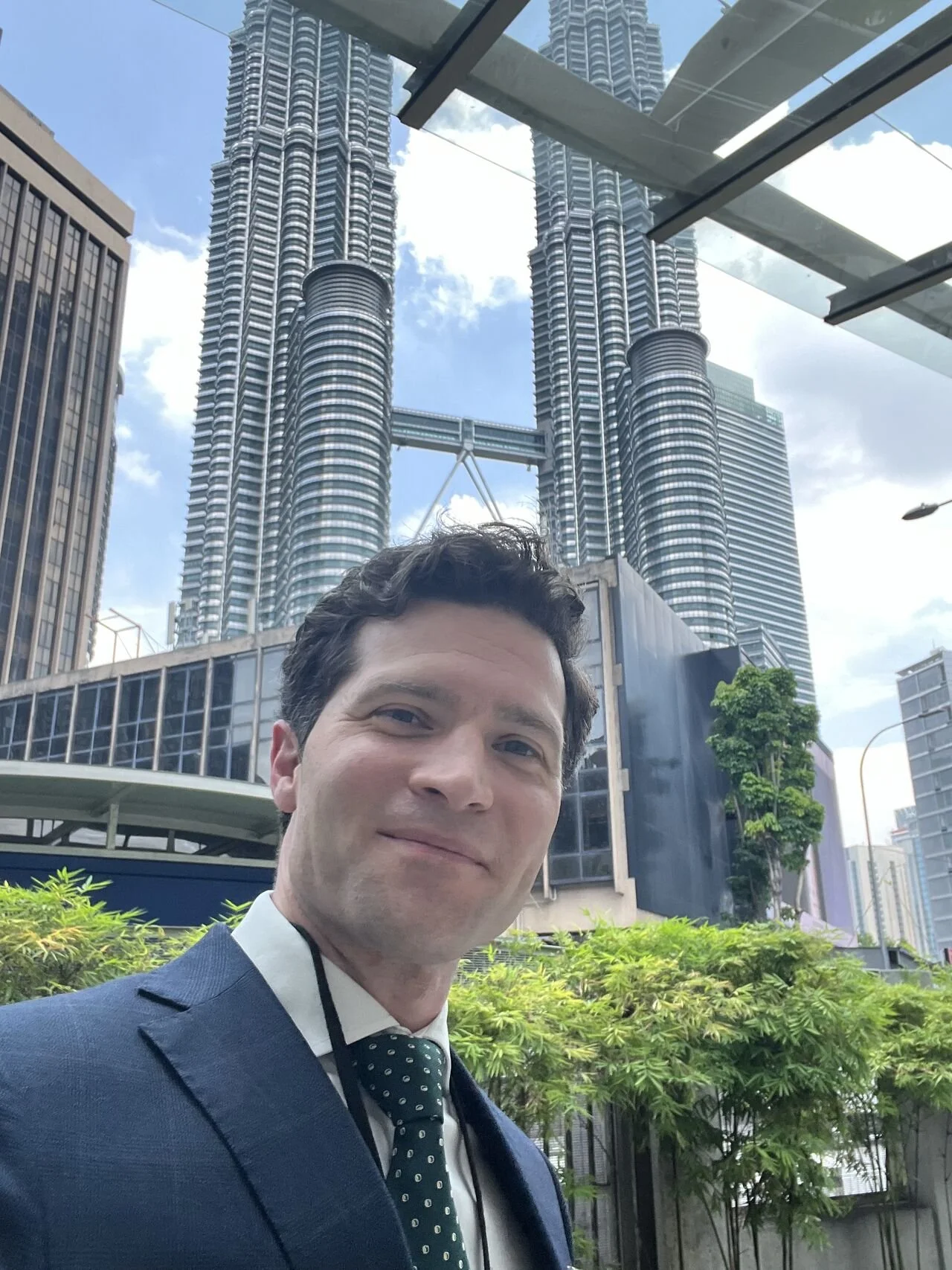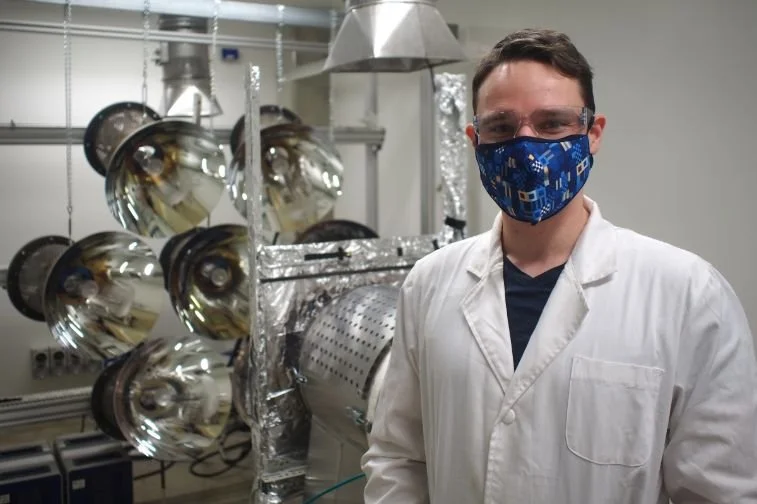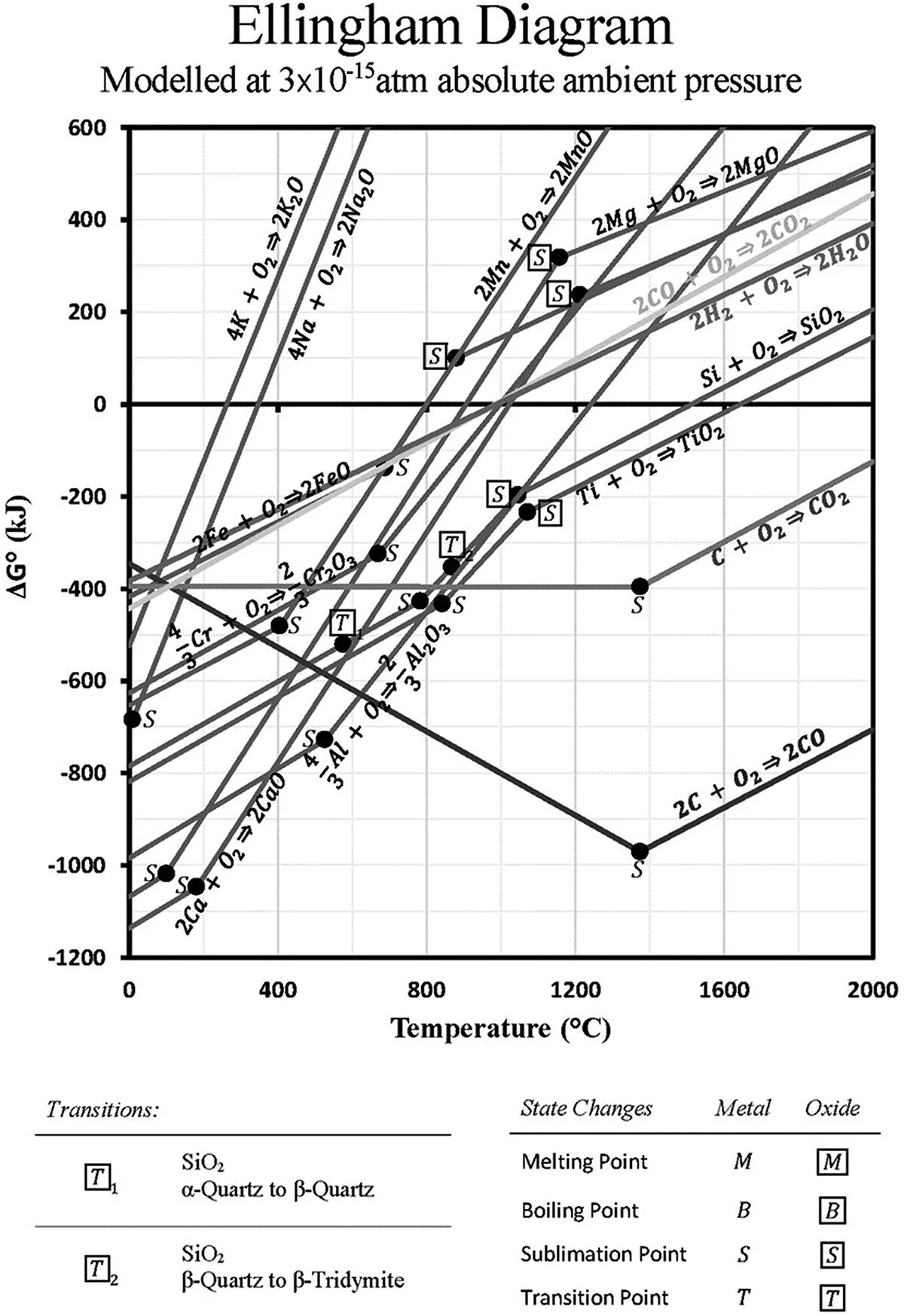
Public
Public profile of Swinburne astronomer Professor Alan Duffy, an experienced communicator with company events, media, appearances, and school talks/public lectures on dark matter, big data, AI, and alien worlds. He is an experienced public speaker, science communicator and leading expert in space science and astrophysics.
Pro Vice Chancellor of Flagship Initiatives at Swinburne University Of Technology, driving large and ambitious transdisciplinary research across our flagship research areas (Space/Aerospace, MedTech Health, Hydrogen and Renewables). From 2021 - 2023, was the founding Director of the Space Technology and Industry Institute and continue as a Professor of Astrophysics @ Swinburne University.
I've spoken at hundreds of events but some particularly unusual opportunities were chatting all things science with Brian Greene as host for "An Evening with Dr Brian Greene", speaking at TEDxSydney in the Sydney Opera House, a Science-Improv night at the Adelaide Fringe, a nation-wide tour with BBC Worldwide / RiAus show The Science of Doctor Who Live and even a Planetarium production on Dark Matter called Dark (now shown in 148 planetariums across 25 countries in 6 languages).
I am incredibly fortunate that I have been able to travel across Australia explaining everything from Black Holes to Aboriginal Astronomy to thousands of students in dozens schools everywhere from inner city private schools to remote indigenous schools in the outback.
See my CV for more.
LATEST events
At EduTech in Sydney, my company mDetect unveiled the classroom-ready EduMOD detectors to bring the wonders of modern physics directly into the classroom, fostering curiosity and deeper understanding. Making abstract physics real and captivating for students, and increasing their engagement and interest in STEM careers - this isn't just about better grades; it's about inspiring future scientists, engineers, and innovators!
Hard to believe the iconic The Project is nearly over… it’s even harder to believe that’s ten years(!) since I failed to convince Freddie Flintoff about a new planet in our solar system (seriously I loved some of the guest hosts!), or getting to share cutting edge science on the desk in front of a live studio audience (I’m amazed my heartbeat wasn’t picked up by the mic), or the honour of a regular segment in over 50 appearances showcasing great science stories shared to Australia in the fun yet informative way only The Project managed to do so well for so many years.
ALL EVENTS
It's hard to overstate the extraordinary life, career, and impact that Dr Jane Goodall DBE had and how much she will be missed by scientists, colleagues in her foundation, communities across the regions of her conservation work, and millions worldwide.
At EduTech in Sydney, my company mDetect unveiled the classroom-ready EduMOD detectors to bring the wonders of modern physics directly into the classroom, fostering curiosity and deeper understanding. Making abstract physics real and captivating for students, and increasing their engagement and interest in STEM careers - this isn't just about better grades; it's about inspiring future scientists, engineers, and innovators!
Hard to believe the iconic The Project is nearly over… it’s even harder to believe that’s ten years(!) since I failed to convince Freddie Flintoff about a new planet in our solar system (seriously I loved some of the guest hosts!), or getting to share cutting edge science on the desk in front of a live studio audience (I’m amazed my heartbeat wasn’t picked up by the mic), or the honour of a regular segment in over 50 appearances showcasing great science stories shared to Australia in the fun yet informative way only The Project managed to do so well for so many years.
The Australian Space Summit 2025 (aka #AusSpace25 sees the best and brightest of the nation and beyond going to Sydney for an intense series of talks, panels, and networking in which we explore and shape Australia's space industry. An incredible event that I will hosted for the third year running, a true honour that I thank Space Connect for bravely/brilliantly (you pick) allowing me to have once more..!
I was particularly excited by the range of emerging and established companies and agencies (and their key decision-makers!) from around the world who came to the ICC in Sydney over two days (Tuesday 27th and Wednesday 28th of May). It’s fair to say this has been a tumultuous year in which our nation has experienced a range of changes, challenges, but also successes. One thing that hasn't changed, however, is the continued growth of the space industry globally, as well as that growth in importance in the Civil and Defence sectors alike.
It truly was an honour to deliver the 18th Ithaka lecture at Sydney Grammar School to a packed theatre of students, parents, and alumni. The concept of the Ithaka lectures follows that of the poem - that the journey and learnings along the way matter more than the destination (or at least the reaching of it!). To that end I took the audience on a journey from the moon landing of Apoll to the explorations and scientific discoveries of space 2.0 today with Artemis. That the current space race is no longer between superpowers alone but also startups. I couldn’t help but raise the amazing efforts of Australian universities, reasearch organisations, and companies in supporting this new era of space - and shared the efforts from CSIRO to Fleet to our own national lunar rover. Somehow I managed to also pack in some breaking cosmological discoveries with the astonishingly powerful James Webb Space Telescope - including how it might be used to detect alien life.
The journey is far from over in the exploration (and perhaps yes exploitation!) of space, and these brilliant young people will play a role in that I have no doubt. My thanks to the teachers at Sydney Grammar School for this chance to speak to hundreds of people and also to Becky Lovelock for the photos from the night!
Thrilled to be joining Bohdee Media as a science advisor! Adam Boland and his colleagues are astonishingly creative and accomplished storytellers *and* social/traditional media creators. And never have those communication skills been more needed… the challenges facing our world will require more science and technology not less, and that tech positive view needs to be heard more widely than ever.
So this was a new one... reporting on a space event in the national news AS IT HAPPENED with the return of the 'stranded' astronauts aboard the International Space Station for 25 MINUTES which demonstrates the investment and excitement of the Australian audiences in a story that was literally out of this world. Coincidentally this day of media frenzy was also my 300th TV appearance since I arrived in Australia a decade and a half ago... what an incredible honour and fun experience to report on groundbreaking science to so many for so long..!
A truly unique experience getting to share the research and commercialisation collaboration between mDetect - Swinburne University of Technology and the The University of Tokyo’s Prof Hiroyuki Tanaka at the Australian Embassy Tokyo. A parntership that is delivering for education, resilience in critical infrastructure, and the resource sector. Getting to be part of an official Trade Delegation is also a first for me and one I cannot thank Austrade, DFAT, and the State of Victoria enough for allowing me to join.
I was fortunate to have the chance to discuss Hydrogen and Swinburne's role in understanding the economic and societal implications, as well as technological opportunities and challenges, for its adoption in Australia, particularly in partnership with Japan, with leading companies Honda and Kawasaki. An unforgettable trip!
One of the coolest ways I get to support my sector of science, technology, and innovation is to help assist those events that celebrate the pioneers and exemplars of our field - and they don’t get any bigger than the night of nights for Australian innovators and technologists with the incredible Australian Academy of Technological Sciences & Engineering's ATSE Awards 2024. So it was truly wonderful to be allowed to host the evening (and also see honoured colleagues I have been privileged also to call my friend for over a decade!)
A whirlwind 2-day tour in Kuala Lumpur learning about the incredible investments and ambitions this nation has in creating an advanced economy through science and technology - the opportunities for Australia to support and learn from this generational shift are enormous, and I’m proud that together with our colleagues at Swinburne’s Sarawak and Australian campuses we can support that change through cutting edge research to enhance businesses as well as staff training in these new economies, but just as importantly creating industry-ready graduates thanks to guaranteed work placements throughout their courses.
It was an honour to brief US Ambassador Caroline Kennedy and Consul General Christine Elder on the myriad industry, education, and workforce opportunities in the space sector for our two nations of Australia and the USA, as part of the AmCham Australia Space Committee. On a personal as well as professional level, this was a highlight..! You could say I was over the Moon with this meeting.
You're looking at Swinburne University of Technology's new Pro Vice Chancellor, Flagship Initiatives 🙌The PVCFI is a new role tasked with driving large and ambitious transdisciplinary research across our flagship research areas by actively engaging with external organisations (including government, industry, NGOs) to identify large-scale opportunities that require university-wide collaboration and the formation of coalitions of universities and partners.
It was a thrill to join The Project on the desk to share the news of NASA’s DART Mission making history as they successfully intercepted an asteroid demonstrating that we can deflect a potential Earth-colliding one in future through an impact with a spacecraft.
I spoke to Australian space pioneer Dr Chris Boshuizen at the Powerhouse Museum about his efforts in space… from a small country town, to co-founding Planet Labs (now the largest Earth Observing satellite fleet in history) to provide open and accessible satellite-based planet monitoring (if you have used Google Maps, you’ve used his company’s images!) and then fulfilling his lifelong dream of space travel onboard the second Blue Origin New Shepard flight in October 2021, making Chris the third Australian in space
It was an incredible honour to host the inaugural Australian Space Summit held in Sydney, bringing together inspiring industry leaders to share with colleagues nationwide the tools and strategies to break into the domestic and global supply chain. I can’t wait for next year!
The precious metals used in our smartphones were forged in dying stars and mined from the Earth at enormous cost, so we aren’t getting any more of them! Yet there are over 4 million unused or broken mobile phones gathering dust in our homes and businesses representing a huge stockpile of valuable materials and metals that can be reclaimed through recycling with MobileMuster in their Go For Zero campaign this year.
Questacon is the national science and technology centre and an absolute treat to get to spend a day visiting but the questions I was asked when there were so tough! What would you have answered?
After years of work from teams worldwide, we are finally nearing the completion of the deepest underground physics laboratory in the Southern Hemisphere all searching for dark matter!
So it was a double thrill that I could take one of Australia's biggest shows - Network 10's #TheProjectTV - on a tour of this Stawell Underground Physics Laboratory
ncreasing amounts of space debris are nearing a critical point, where unavoidable collisions will cause more debris, in a disastrous chain reaction that will make space inaccessible to us. This has been termed the Kessler Syndrome. Once the cascading collisions begin, they cannot be stopped.
As I explain in this thought piece for the The Age, Australia has an important role in this global issue as we monitor vast skies with space technologies that few others in the Southern Hemisphere have.
Image by ESA
I’m beyond thrilled to celebrate our Space Institute PhD student Matt Shaw and his incredible win at the 3MT APAC international finals. Against entries by 54 universities from around the region his work on mining the moon to provide metals for constructing moonbases (seriously how cool is his Thesis) was found the most engaging - considering you have just Three Minutes(!) to explain three years of work, his efforts to connect with the audience are nothing short of amazing
When it comes to mining the Moon, and how best to extract those critical resources, for fuelling our further exploration of the Solar System this massive review paper will be seen as a critical resource itself! Incredibly work by Matthew Shaw and Matthew Humbert, two doctoral candidates within the Extraterrestrial Resource Processing group led by Profs Geoff Brooks and Akbar Rhamdhani, at Swinburne’s Space Technology and Industry Institute.
Incredible news as one of the largest Federal Government’s Modern Manufacturing Initiative grants ($2.325M from Gov, for a total expenditure of $4.65M) is awarded to Titomic and Swinburne!
A seamlessly connected world, where information streams effortlessly across people, industry, cities, farms and satellites. In which data that originates from Earth is conveyed and used as easily as the data generated from sensors in orbit. All of which is combined to inform decisions in either domain.
This is the Internet of Space Things (IoST), and it is the natural future extension of the internet as the predominant communications and data-exchange structure of our time. We already have half a dozen devices connected to the Internet of Things for every person on Earth, producing 79 ZETA bytes of information (that’s nearly a million million 4k movies worth of data!) by 2025, the options in using this data are endless and the future is seamless.
In the next two decades we will search the skies, solar system and space for alien life with new techniques and technologies thousands of times more powerful than all of humanity's efforts to date. I toured the world speaking to experts in this search for alien life, as well as the kinds of life we might uncover, and of course a serious investigation into the claims that it may already be here(!)
My thanks to Audible for making possible this incredible journey. I hope you enjoy listening to what I discovered with Astronomical - Looking for Life Beyond Earth
I got a chance to speak to the space and spatial focussed Locate podcast about all things to do with space, the industry, my efforts and more. It was a lot of fun chatting with Alicia and Roshni, I hope you enjoy it too!
It is a pleasure to be the MobileMuster Program Ambassador and support their campaign to have Australian's send in the 5 *million* broken smartphones lying around in homes nationwide. If our campaign is a success we will have recovered nearly 10,000 tonnes of precious minerals and metals, as well as the CO2 saved equivalent to planting 50000 trees. All from us collectively sending in our broken phones!
Let's #GoForZero broken phones at home this March.
I'm beyond thrilled to announce that I have been appointed the inaugural Director of the new Space Technology and Industry Institute at Swinburne University of Technology !
I can’t wait to help companies and communities solve their problems on Earth through Space, together with my amazing Swinburne colleagues.
This is a staggering, and very surprising, announcement by the Australian Space Awards to name me the Academic of the Year! This is particularly so given the incredible and world-leading efforts of my fellow finalists in this category.
Space is a multidisciplinary domain so my individual Award is actually a team Award in reality - and one that recognises my extraordinary Swinburne colleagues (Virginia Kilborn, Bronwyn Fox, James Davern and Geoff Brooks to name but a few!) who have worked so hard to make our collective efforts deserving of this recognition, efforts that are truly out of this world.
Melbhenge is where the Sun sets at 7:57pm (get there at least 15 minutes before) at exactly 250 degrees, meaning it aligns perfectly with a mile of skyscrapers in Melbourne’s Hoddle-grid. Remember, please don’t look directly at the Sun! But viewed safely this is a truly gorgeous evening event (just enjoy J L R Reyes’s work from last year!) and finding exactly the best place to view is always important. This year it’s particularly important we move out across the city to find the best spot (tag your photo with location and #Melbhenge) as we have to ensure we keep a safe, social distance from one another. So be safe and enjoy the Sun responsibly friends.






























It's hard to overstate the extraordinary life, career, and impact that Dr Jane Goodall DBE had and how much she will be missed by scientists, colleagues in her foundation, communities across the regions of her conservation work, and millions worldwide.